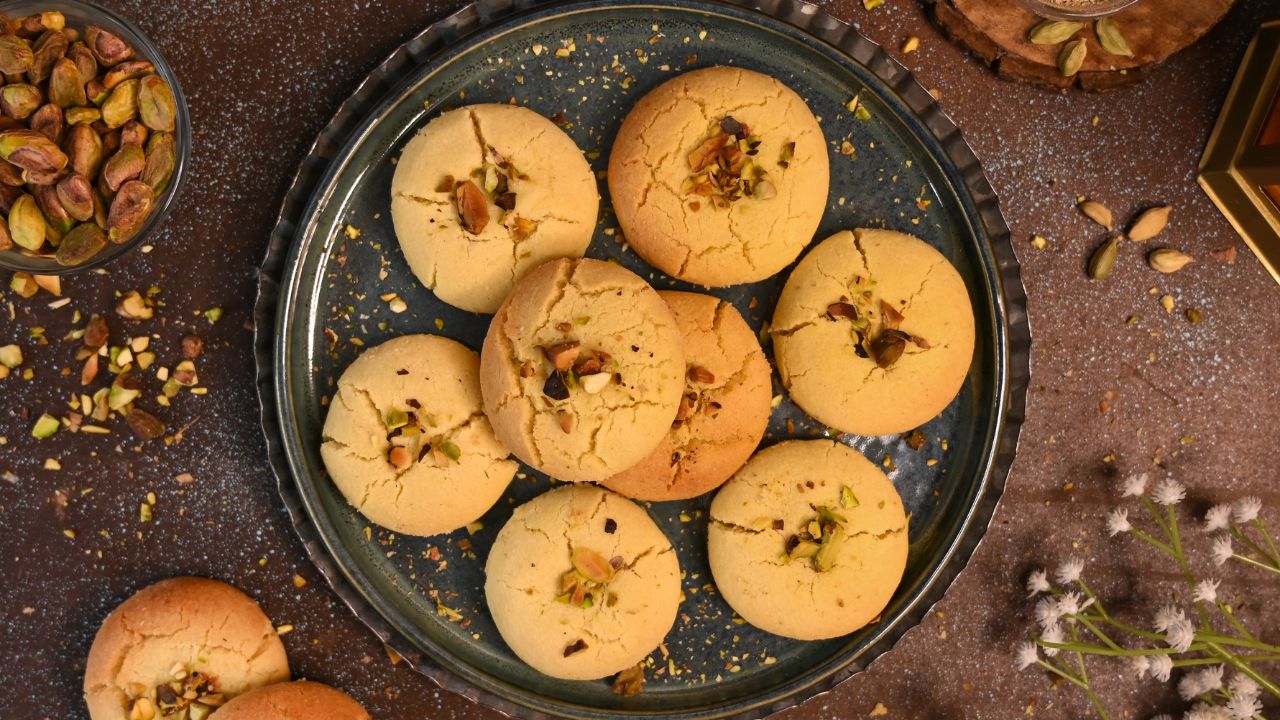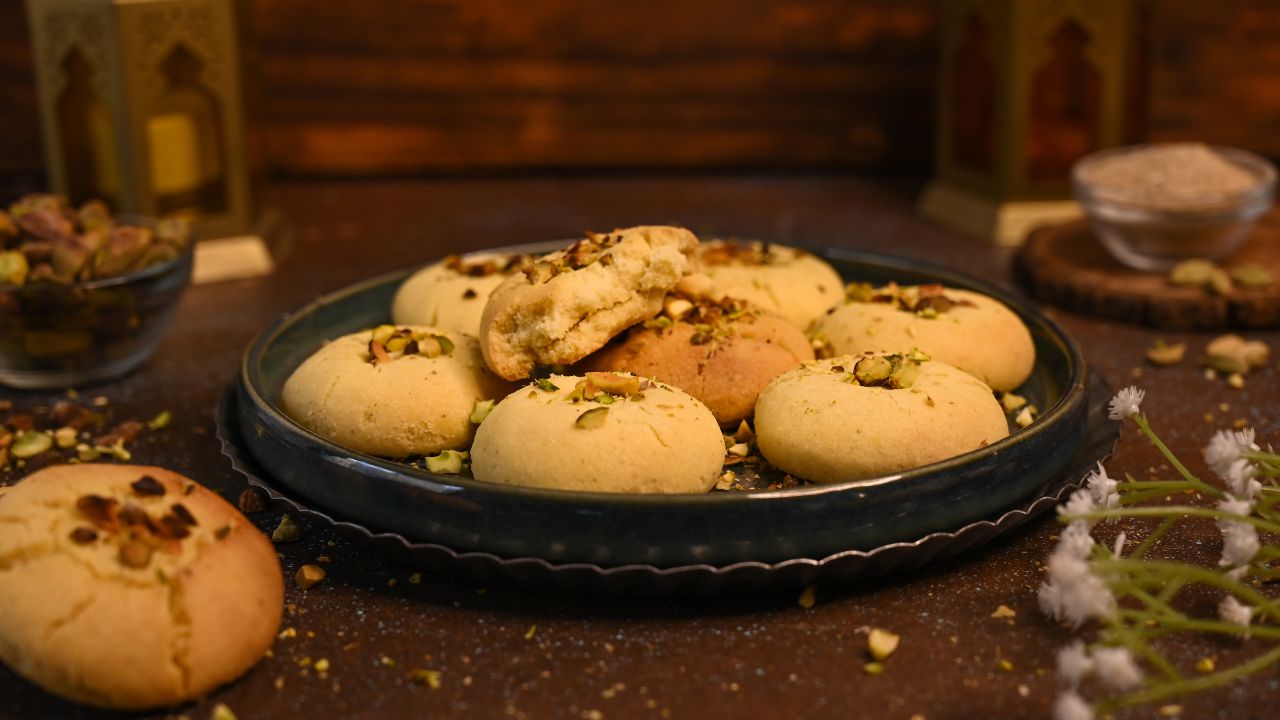A biscuit that is soft, crumbly, crunchy, and flaky – all textures packed in one dessert! And to top it all, they are melt-in-the-mouth buttery biscuits. Sounds fantastic, right? I’m referring to the great Nankhatai Biscuits!
Nankhatai is an Indian Shortbread biscuit that originated in Surat, Gujarat, during the 16th Century. They are made using simple ingredients but turn out to be these amazing, delicious biscuits.
They have a flaky and crunchy exterior yet a soft, tender, and crumbly interior. They are the perfect partner for your tea or coffee. They are not overly sweet, so they pair well with hot beverages.
Being an Indian, these cookies or biscuits were available in every big or small bakery. Every household would have these to eat them with their morning and evening tea. Naturally, I used to eat them, too, and simply loved them. One was never enough.
With this recipe, I would like to take you down that memory lane where all Indian kids had this biscuit and relished it. For those who haven’t tried Nankhatai before, you must try this recipe, and trust me, you will bake this every day!
Nankhatai Recipe Video Video Tutorial
Why You’ll Love This Recipe?
- Unique Texture: Just like the English shortbread cookie, Nankhatai also has a mix of textures. It’s crunchy from the outside but soft and tender from the inside. That’s the texture I enjoy the most in a homemade biscuit.
- The flavor: The cookie is flavored with cardamom powder and topped with some chopped pistachios. It has chickpea flour and semolina, too, which give it a unique taste. Also, since it’s made using ghee, otherwise known as clarified butter, it has a nice butter flavor to it.
- Easy-To-Make: Nankhatai requires minimal ingredients, which are generally available in every household kitchen. The recipe is very simple to follow, making these biscuits relatively easy to make.
Important Ingredients Used In The Recipe
- Ghee/Clarified butter: Being originated from India, nankhatai was invented using ghee as fat, which is a common fat available in an Indian kitchen. Ghee is nothing but clarified butter, where butter is cooked to remove excess water, leaving pure fat. I would recommend using ghee and not butter to get the right texture and authentic flavor.
- All-Purpose flour: Like any other cookie or biscuit, Nankhatai is also made using all-purpose flour. It provides the right texture and structure to the biscuit.
- Besan/chickpea flour: Nankhatai have a hint of yellow color in them. That’s because it contains chickpea flour. Being gluten-free, using this flour helps make the cookie crumbly.
- Semolina: Semolina adds a pleasant, crispy, and crunchy texture to the biscuits.
- Icing Sugar: Nankhatai is made using powdered sugar and not castor sugar. This is because of the compact and snappy texture we need, which we can get from icing sugar only.
- Cardamom powder: To provide a nice flavor to the biscuits, cardamom powder is added. It adds a lovely fragrance as well. Since the Cardamom flavor is a spice from India and is commonly used in Indian sweets, it was added to the biscuits, too.
- Pistachios: These rich green pistachios are added as a garnish on the top center of the cookies. It adds a great crunch and nutty flavor to the biscuits.
How To Make Nankhatai?
Preparation: Collect all ingredients with their correct measurement in separate bowls. Line a baking tray with butter paper or a silicone mat. Preheat the oven to 180C (OTG mode: upper rod + lower rod + fan).
Sieve Dry Ingredients: In a large mixing bowl, sieve the dry ingredients, which are flour, chickpea flour, semolina, icing sugar, cardamom powder, and salt. Give this a quick mix.
Add Ghee: Now, add ghee/clarified butter to the dry mixture and mix it using your hands. Combine well to form a smooth dough.
Shaping: once the dough is ready, take 30 g of the dough and shape it into a ball. Flatten it a little and place it on a lined baking tray. Repeat the process for the remaining dough.
Garnish: Place some chopped pistachios at the center of each biscuit for garnish.
Bake: Put the tray for baking at 180C (OTG mode: upper rod + lower rod + fan) for 12-15 minutes.
Cool and serve: Let the nankhatai cool down before serving.

Chef’s Tips For The Recipe
Use Gloves While Mixing
When making the dough, wear gloves for hygiene purposes. Also, the heat of the palm may melt ghee while mixing and shaping. Glaciers will prevent that from happening.
Tip For Baking
While baking, you may rotate the tray after half of the baking time has crossed. This will allow all biscuits to get even heat from each corner.
How To Store Nankhatai
Baked Nankhatai must be stored in an airtight box at room temperature. You can consume it within 7-10 days.
If you have some dough left, then you can cling wrap it and store it in the refrigerator for ten days or in the freezer for two months.
More Easy Recipes
Cookies are the most fun and easy baking dessert. Check out some of these amazing cookie recipes.
Frequently Asked Questions
‘Naan’ means bread, and ‘khatai’ means biscuit in Afghan. Therefore, the Indian Shortbread Biscuits were named Nankhatai.
Yes, you may use almonds instead of pistachios if you wish to.
I would recommend using traditional ghee for the recipe. However, you can replace it with soft butter in the same quantity as ghee.

